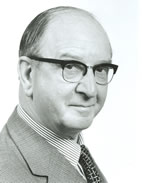Articles from this issue
- Clinical Section Report
- Schachter Awards 2004
- Meetings Report
- Daphne Jackson Trust
- An Appeal for Help
- Henry Adam (1911-2004)
Volumes
Issues
VOLUME 2 - ISSUE 4 - HENRY ADAM (1911-2004)
Dr Henry Matthew Adam, formerly Reader in Pharmacology at Edinburgh University, died on 18 June 2004 in Edinburgh, at the age of 93. He was an editor of the British Journal of Pharmacology from 1960-1967, during a time of expansion and modernisation, and secretary of its editorial board from 1971-76.
The son of a Scottish engineer and his Italian wife, Henry was born on 11 May, 1911 in London while his itinerant parents were in transit between Moscow and Rome. His early education was fragmented as he was bounced from Rome to Manchester and then to Madrid. It was a chance comment by a colleague of his father’s about how happy his son was at George Watson’s College, Edinburgh, that propelled the 15 year-old Henry to the city that was to become the love of his life. Watson’s paved his way to the Medical School of Edinburgh University from which he graduated MB ChB in 1935.
As an undergraduate he was inspired by several teachers. Among these were P Eggleton – a pioneer in the teaching of biochemistry in whose lab Henry worked during a gap-year between the second and third years of the course – and G Barger, a brilliant organic chemist who occupied the Chair of Chemistry in Relation to Medicine and was a former collaborator of Sir Henry Dale.
By the time he qualified, the young Henry was more interested in the scientific aspects of medicine than in becoming a GP. He confided as much to W C Wilson of the Department of Surgical Research. Wilson was about to be appointed by the MRC as Director of a new unit, the Wilkie Research Laboratories, where experimental work could be conducted on both laboratory animals and humans in relation to clinical problems. Convinced by Henry’s enthusiasm, Wilson secured first a McCunn Medical Research Scholarship and then a Leckie-Mactier Fellowship for him to assay acetylcholine levels in cerobrospinal fluid.
Henry was just beginning to establish himself as a promising research worker when the Second World War intervened. He served in the RAMC, first on trooping duties in convoys to the Middle East and in Field Ambulance work, then as pathologist at the Chemical Defence Experimental Station, Porton Down. Finally, as a member of the US Army ALSOS mission for Scientific Intelligence, he entered the Nazi extermination camp at Buchenwald (where the Germans had been experimenting with the effects of typhus on prisoners) in order to rescue scientists before the Russians arrived
On demobilisation Henry returned to Edinburgh University where, in 1947, J.H. Gaddum offered him a Lectureship in Pharmacology. He entered a field populated by scientific giants attempting to determine the levels of amines in body tissues and their functions using biological assays rather than chemical methods. Henry chose to look at histamine and take part in the debate on whether it had a role in the running of the healthy body or whether it should be relegated to the sphere of pathology, responsible for such dire effects as anaphylactic shock and asthma. By 1950 it looked as though the second possibility was nearer the truth but Henry, with his passion for accurate measurement and experimentation, managed to overturn that view. He found that histamine is present in the blood and urine of healthy individuals all the time. He went on to demonstrate first its vital role in digestion by acting as a hormone stimulating acid secretion in the stomach, and later its participation in the activity of the normal brain. His lectures to medical students were much appreciated, even followed by applause, and he contributed substantially to the multivolume textbook Companion to Medical Studies edited by R V Passmore and other Edinburgh colleagues.
Henry was elected a Fellow of the Royal Society of Edinburgh in 1954. After a year as visiting professor at Yale University, attempts were made to lure him away from Edinburgh to posts in England and the USA, but he would have none of them: Edinburgh was where he belonged. With a marked capacity for conversation and friendship, Henry could talk about anything under the sun, but shining through it all was his pride in the City of Edinburgh, its history, its University, its medical tradition and, especially, its contribution to the Enlightenment.
In 1940, Henry married the zoologist Katherine Mary Galbraith Fleming. After her death in 1996 he soldiered on alone, maintaining his extraordinary geniality and sense of wonder to the end.
Keith Vickerman
Regius Professor of Zoology Emeritus
University of Glasgow
